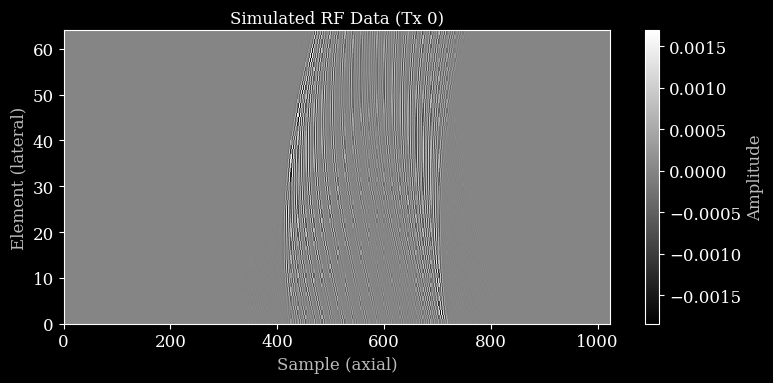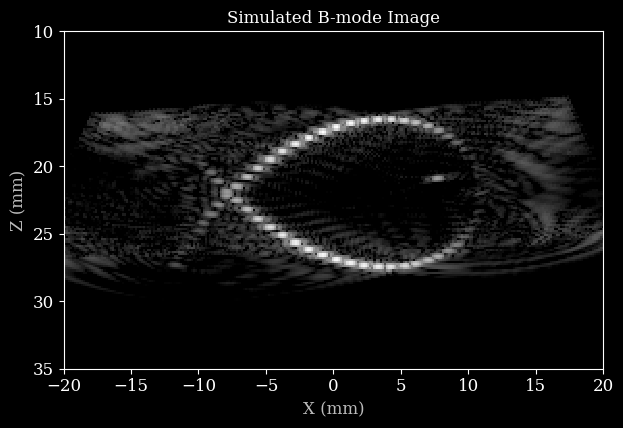Simulating ultrasound data with zea¶
This notebook demonstrates how to simulate ultrasound RF data using the zea toolbox. We’ll define a probe, a scan, and a simple phantom, then use the simulator to generate synthetic RF data. Finally, we’ll visualize the results and show how to process the simulated data with a zea pipeline.
[1]:
%%capture
%pip install zea
[2]:
import os
os.environ["KERAS_BACKEND"] = "jax"
os.environ["ZEA_DISABLE_CACHE"] = "1"
[3]:
import matplotlib.pyplot as plt
import numpy as np
import zea
from zea import init_device
from zea.simulator import simulate_rf
from zea.probes import Probe
from zea.scan import Scan
from zea.beamform.delays import compute_t0_delays_planewave
from zea.visualize import set_mpl_style
from zea.beamform import phantoms
zea: Using backend 'jax'
WARNING: All log messages before absl::InitializeLog() is called are written to STDERR
E0000 00:00:1753272053.021546 1256857 cuda_dnn.cc:8579] Unable to register cuDNN factory: Attempting to register factory for plugin cuDNN when one has already been registered
E0000 00:00:1753272053.027274 1256857 cuda_blas.cc:1407] Unable to register cuBLAS factory: Attempting to register factory for plugin cuBLAS when one has already been registered
W0000 00:00:1753272053.042104 1256857 computation_placer.cc:177] computation placer already registered. Please check linkage and avoid linking the same target more than once.
W0000 00:00:1753272053.042121 1256857 computation_placer.cc:177] computation placer already registered. Please check linkage and avoid linking the same target more than once.
W0000 00:00:1753272053.042123 1256857 computation_placer.cc:177] computation placer already registered. Please check linkage and avoid linking the same target more than once.
W0000 00:00:1753272053.042124 1256857 computation_placer.cc:177] computation placer already registered. Please check linkage and avoid linking the same target more than once.
[4]:
init_device(verbose=False)
set_mpl_style()
Let’s define a helper function to plot RF data.
[5]:
def plot_rf(rf_data, title="RF Data", cmap="gray"):
"""Plot the first transmit and first channel of the RF data."""
plt.figure(figsize=(8, 4))
plt.imshow(
rf_data[0, 0, :, :, 0].T,
aspect="auto",
cmap=cmap,
extent=[0, rf_data.shape[2], 0, rf_data.shape[3]],
)
plt.xlabel("Sample (axial)")
plt.ylabel("Element (lateral)")
plt.title(title)
plt.colorbar(label="Amplitude")
plt.tight_layout()
Define zea.Probe and zea.Scan¶
We’ll use a linear probe and a simple planewave scan for this simulation. Let’s start with the probe definition.
[6]:
# Define a linear probe
n_el = 64
aperture = 20e-3
probe_geometry = np.stack(
[np.linspace(-aperture / 2, aperture / 2, n_el), np.zeros(n_el), np.zeros(n_el)], axis=1
)
probe = Probe(
probe_geometry=probe_geometry,
center_frequency=5e6,
sampling_frequency=20e6,
)
Now we’ll define the necessary parameters for the scan object.
[7]:
# Define a planewave scan
n_tx = 3
angles = np.linspace(-5, 5, n_tx) * np.pi / 180
sound_speed = 1540.0
# Set grid and image size
xlims = (-20e-3, 20e-3)
zlims = (10e-3, 35e-3)
width, height = xlims[1] - xlims[0], zlims[1] - zlims[0]
wavelength = sound_speed / probe.center_frequency
grid_size_x = int(width / (0.5 * wavelength)) + 1
grid_size_z = int(height / (0.5 * wavelength)) + 1
t0_delays = compute_t0_delays_planewave(
probe_geometry=probe_geometry,
polar_angles=angles,
sound_speed=sound_speed,
)
tx_apodizations = np.ones((n_tx, n_el)) * np.hanning(n_el)[None]
Now we can initialize the scan object with the defined parameters.
[8]:
scan = Scan(
n_tx=n_tx,
n_el=n_el,
center_frequency=probe.center_frequency,
sampling_frequency=probe.sampling_frequency,
probe_geometry=probe_geometry,
t0_delays=t0_delays,
tx_apodizations=tx_apodizations,
element_width=np.linalg.norm(probe_geometry[1] - probe_geometry[0]),
focus_distances=np.ones(n_tx) * np.inf,
polar_angles=angles,
initial_times=np.ones(n_tx) * 1e-6,
n_ax=1024,
xlims=xlims,
zlims=zlims,
grid_size_x=grid_size_x,
grid_size_z=grid_size_z,
lens_sound_speed=1000,
lens_thickness=1e-3,
n_ch=1,
selected_transmits="all",
sound_speed=sound_speed,
apply_lens_correction=False,
attenuation_coef=0.0,
)
Simulate RF Data¶
Let’s simulate some RF data using the simulate_rf function and initialize a scatterer phantom.
[9]:
# Create the phantom scatterer positions and magnitudes
positions = phantoms.fish()
magnitudes = np.ones(len(positions), dtype=np.float32)
rf_data = simulate_rf(
scatterer_positions=positions,
scatterer_magnitudes=magnitudes,
probe_geometry=probe.probe_geometry,
apply_lens_correction=scan.apply_lens_correction,
lens_thickness=scan.lens_thickness,
lens_sound_speed=scan.lens_sound_speed,
sound_speed=scan.sound_speed,
n_ax=scan.n_ax,
center_frequency=probe.center_frequency,
sampling_frequency=probe.sampling_frequency,
t0_delays=scan.t0_delays,
initial_times=scan.initial_times,
element_width=scan.element_width,
attenuation_coef=scan.attenuation_coef,
tx_apodizations=scan.tx_apodizations,
)
print("Simulated RF data shape:", rf_data.shape)
Simulated RF data shape: (1, 3, 1024, 64, 1)
Visualize RF Data¶
Let’s plot the simulated RF data for the first transmit.
[10]:
plot_rf(rf_data, title="Simulated RF Data (Tx 0)")

Process simulated data with zea.Pipeline¶
We can process the simulated RF data using a Zea pipeline to obtain a B-mode image.
[11]:
pipeline = zea.Pipeline.from_default(pfield=False, with_batch_dim=False, baseband=False)
parameters = pipeline.prepare_parameters(probe, scan, dynamic_range=(-50, 0))
inputs = {pipeline.key: rf_data[0]} # Use first batch
outputs = pipeline(**inputs, **parameters)
image = outputs[pipeline.output_key]
image = zea.display.to_8bit(image, dynamic_range=(-50, 0))
plt.figure()
plt.imshow(
image,
cmap="gray",
extent=[
scan.xlims[0] * 1e3,
scan.xlims[1] * 1e3,
scan.zlims[1] * 1e3,
scan.zlims[0] * 1e3,
],
)
plt.xlabel("X (mm)")
plt.ylabel("Z (mm)")
plt.title("Simulated B-mode Image")
plt.tight_layout()

That’s it! You have now simulated ultrasound RF data and reconstructed a B-mode image using zea.
